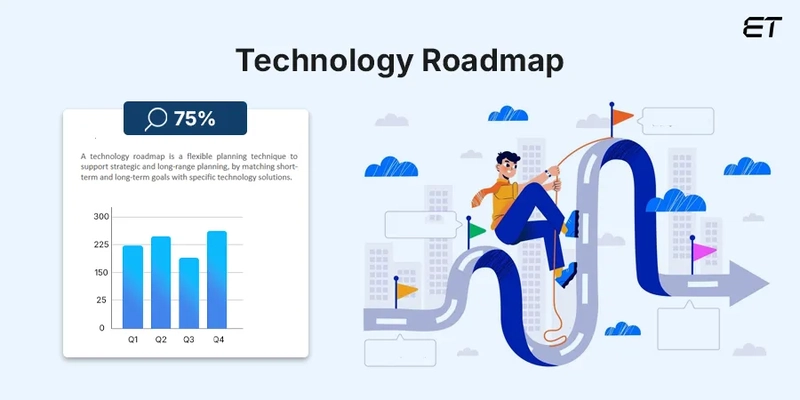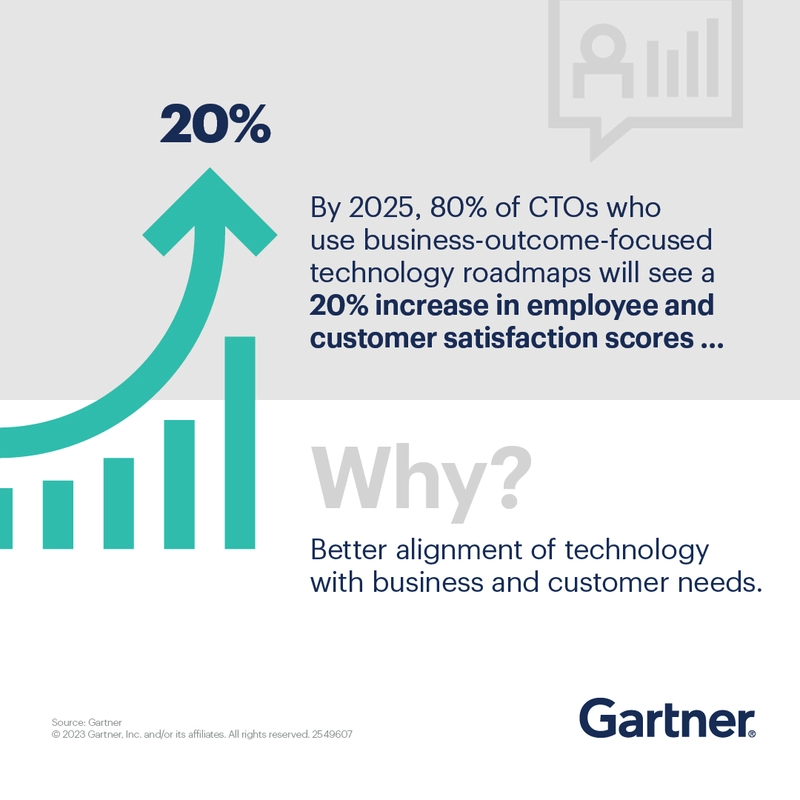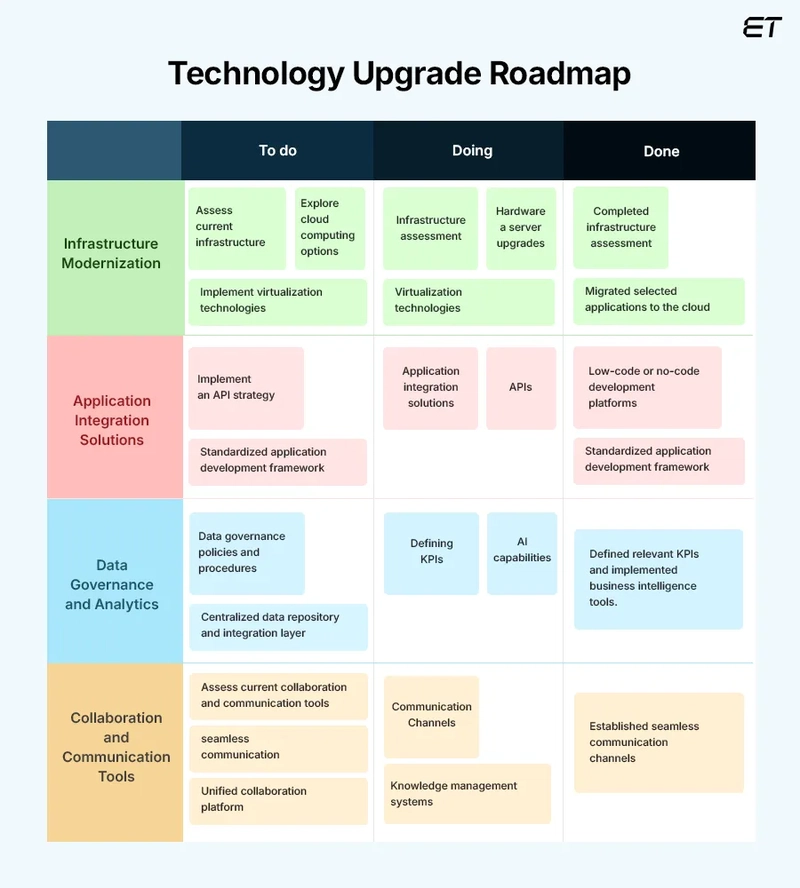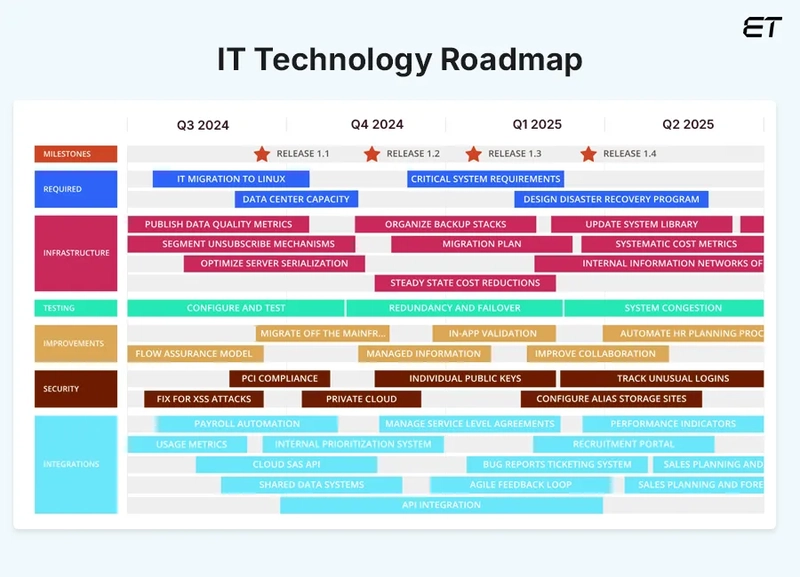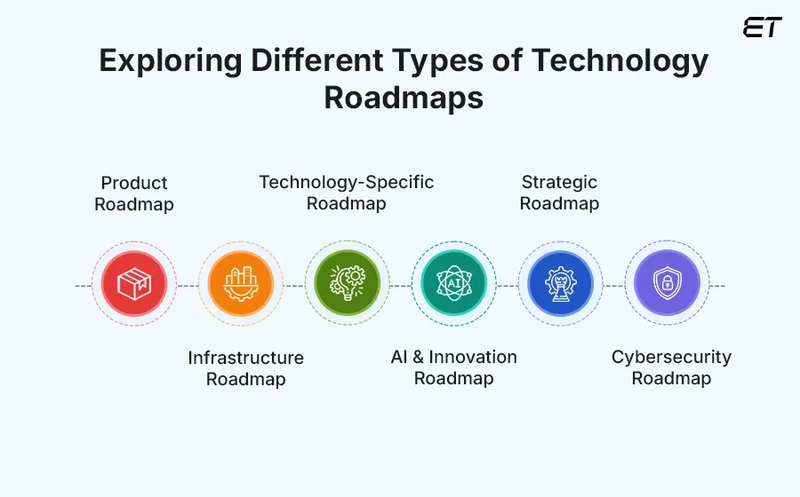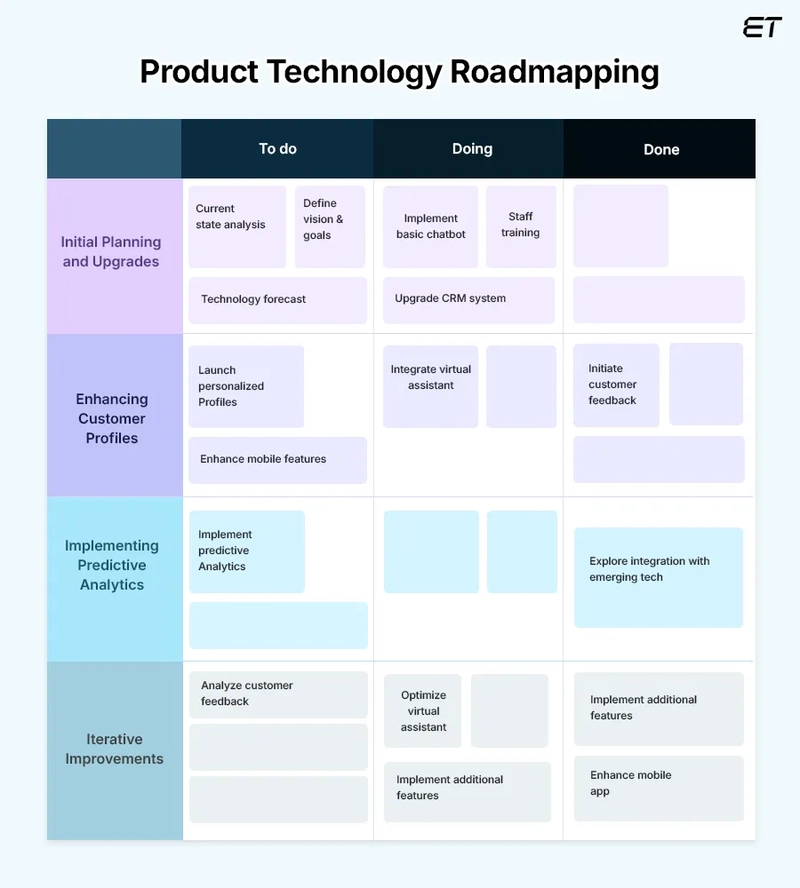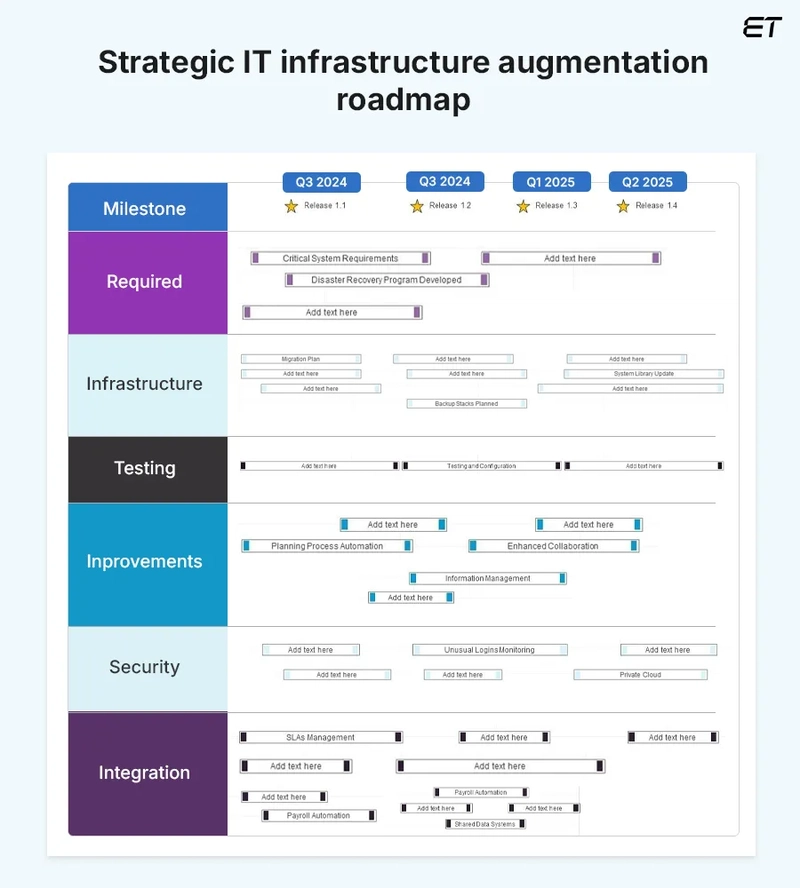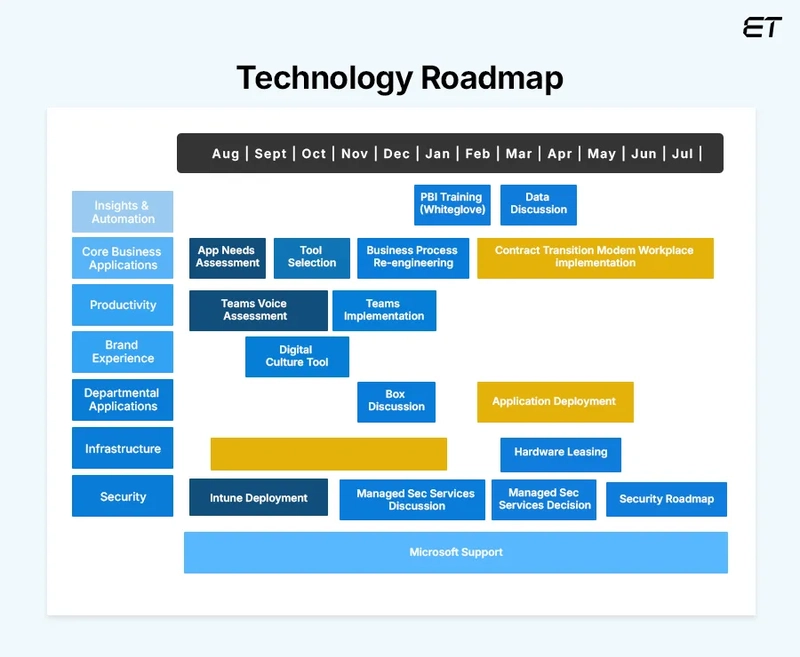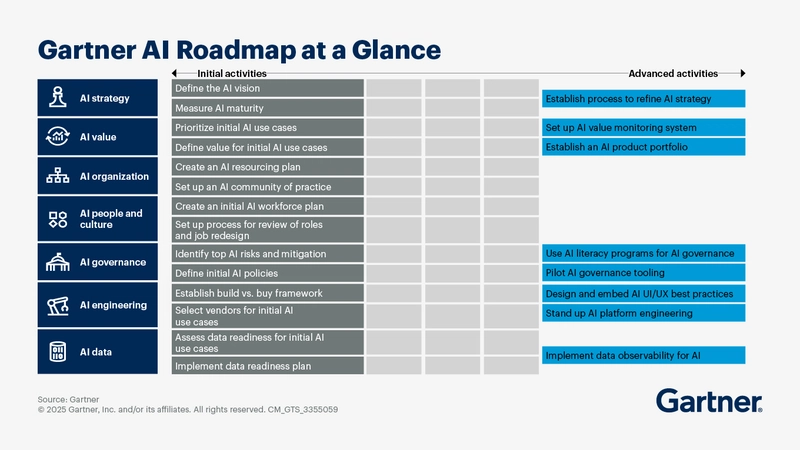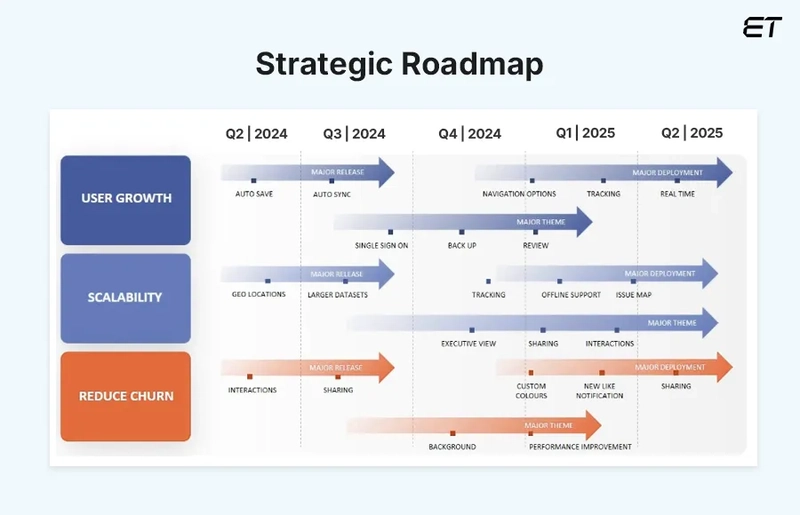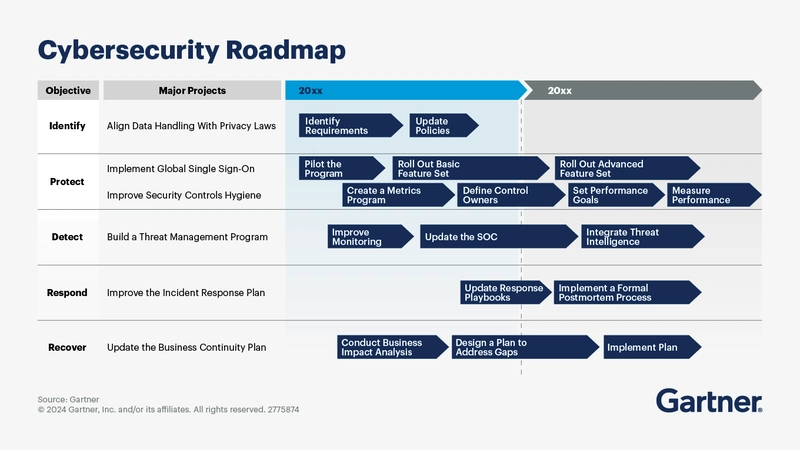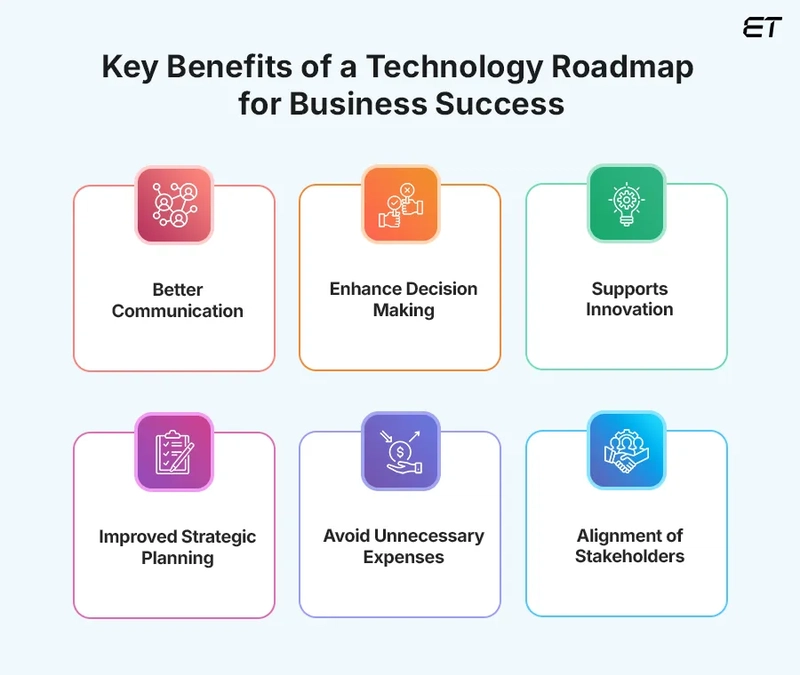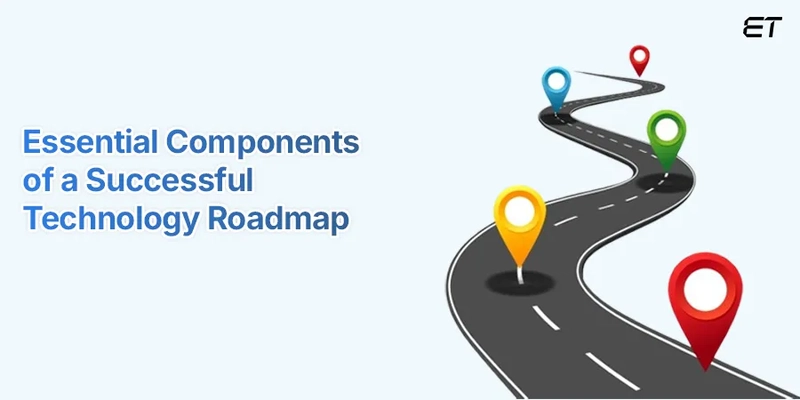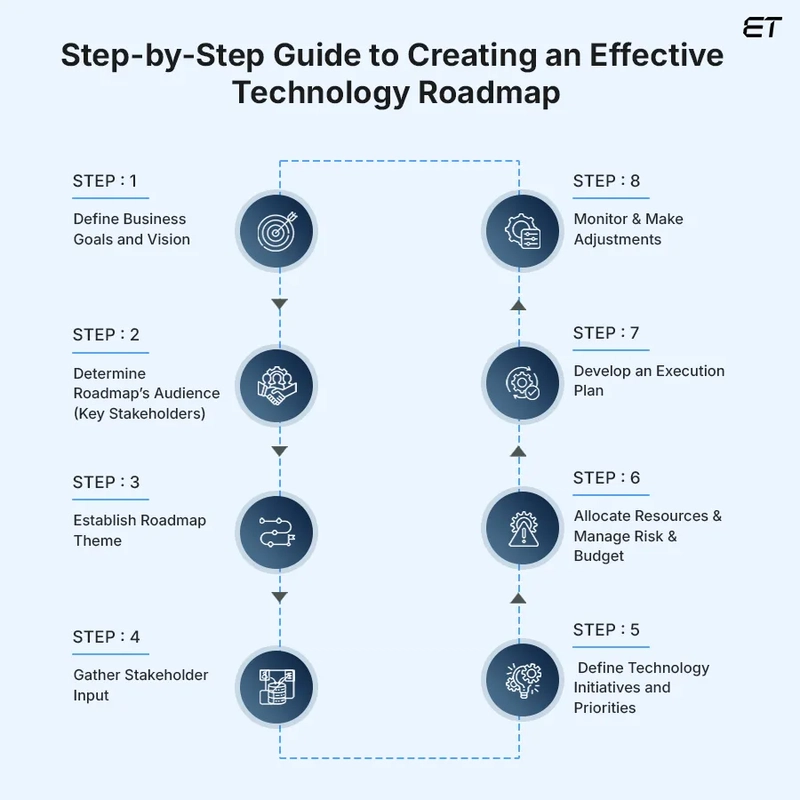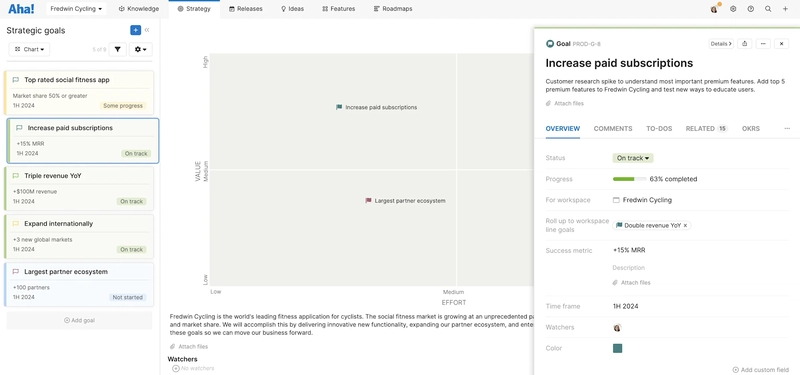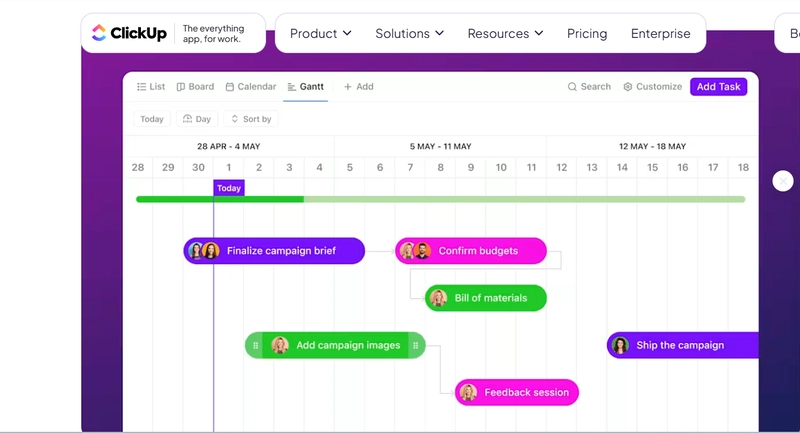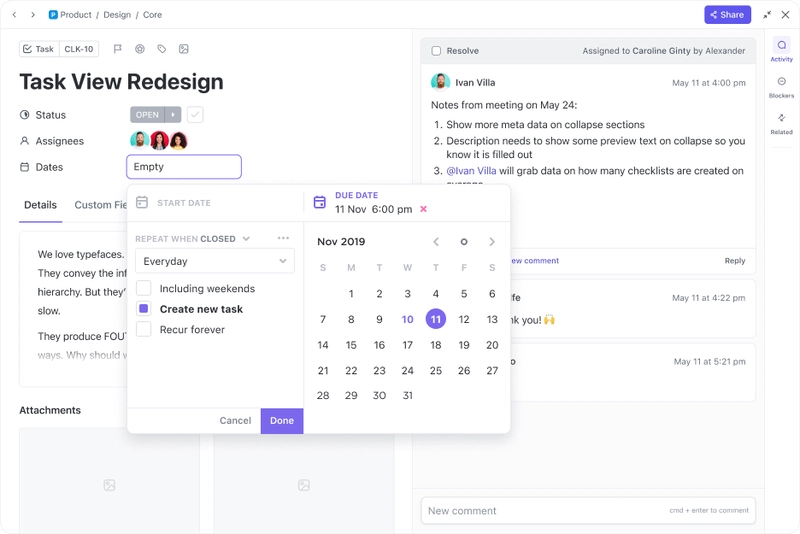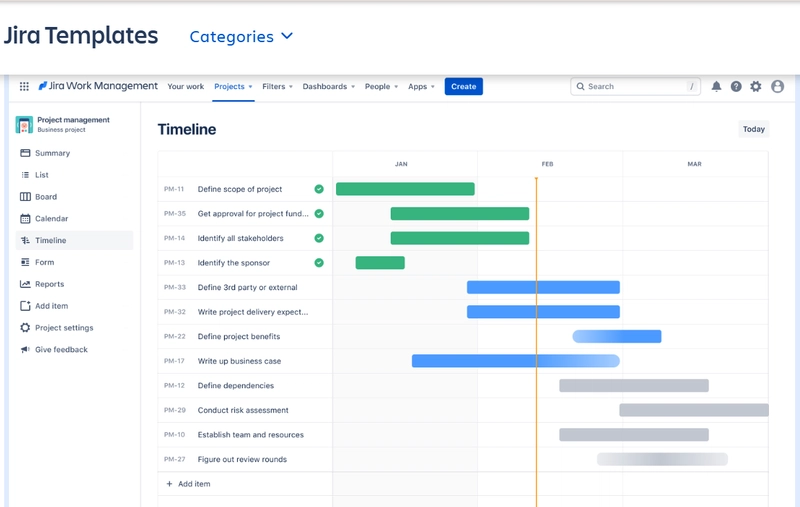CTO’s Guide to Effective Technology Roadmaps
Does your team feel overwhelmed by endless technology choices? As markets evolve and consumer needs shift, businesses must bring changes to stay competitive. A technology roadmap is your compass, guiding you through the chaos. But what exactly is it, and why does your business need one? Let’s dive in! This blog will answer all your questions about why, when, and how to create a technology roadmap. But if you want a quick glimpse, check out the example below! “A healthcare company implementing electronic health records (EHR) used a technology roadmap to streamline adoption, ensuring seamless integration, staff training, and data security. This strategic planning reduced downtime, improved patient care, and aligned IT investments with long-term business goals.” Technology or IT roadmaps are visual representations of your strategy plan for using technology to assist your business and clients. They can be a hidden weapon for navigating technological changes and ensuring they support a company's objectives while also helping to create a vision for the future. According to Statista, between 2023 and 2027, over 86% of businesses intend to use digital platforms and apps. However, any modification to a company's technological environment might be challenging. Preparing for these shifts can be difficult, but a firm cannot only survive but also prosper during downturns if it has the proper information, research, and—above all—a well-defined plan that empowers them to face the challenges with confidence and security. The technological roadmapping directs email migrations, network improvements, and software rollouts to ensure seamless changes. The roadmaps provide a coordinated approach to digital modernization, ensuring a structured and strategic transition. They offer reassurance and reduce stress by aligning stakeholders through clear objectives, deadlines, and essential activities. This article explores the idea of a technology roadmap, outlining its goals while giving guidelines for creating one that will guarantee a successful and seamless technological journey. Learn how to incorporate product development as well for a more seamless future. Turn your ideas into a successful product with the right strategic roadmapping approach for efficient planning and execution. Learn How What is a Technology Roadmap? Everything You Need to Know A technology roadmap is a planning tool in which an organization's technology efforts' vision, direction, and progress are described. Its main goal is to match technological projects and investments with the main business goals. It is basically a visual depiction of your technological path that highlights significant turning points, dependencies, and resource needs. If applicable, a successful technology roadmap should also include a plan for achieving both short- and long-term objectives related to digital transformation. Image Source A technology roadmap brings your development, project management, and other teams together by connecting your IT needs with business objectives. Your management and technology teams may clearly outline a course for the future by documenting this journey, which will help you match your investments with your long-term goals. A lot of software development teams illustrate their roadmaps using tools like Canny or GitHub. However, other teams still use spreadsheets to organize their roadmaps. Well-known examples are Google Sheets and Airtable. Let’s take some simple examples to comprehend this topic further. Understanding Technology Roadmaps with a Real-World Example Here are a few examples of technology roadmaps to help you understand their structure and implementation, providing insights into how they are designed and executed for strategic planning. Technology Upgrade Roadmap Example In this dynamic digital world, companies frequently have to update or upgrade their current technological infrastructure. A company may develop a roadmap to upgrade its server infrastructure, replacing aging servers with cloud-based solutions, adopting new cybersecurity protocols, and enhancing data storage capabilities. The technological complexities that a business may face are captured in this roadmap, which is more than just a strategy for linear advancement. By predicting the organization's technological demands and trends, it facilitates efficient decision-making to optimize expenditures and resources and guarantee uninterrupted company operations. Have a look at the below template, which top software development companies generally follow for technology upgrades Key components of a technology upgrade roadmap include: Assessment of current technology: Identify existing bottlenecks or limitations in the infrastructure. Planning and research: Determine which technologies need to be upgraded, researched, or replaced. Execution phase: Install new software, replace outdated hardware, and ensure smooth integration with the existi
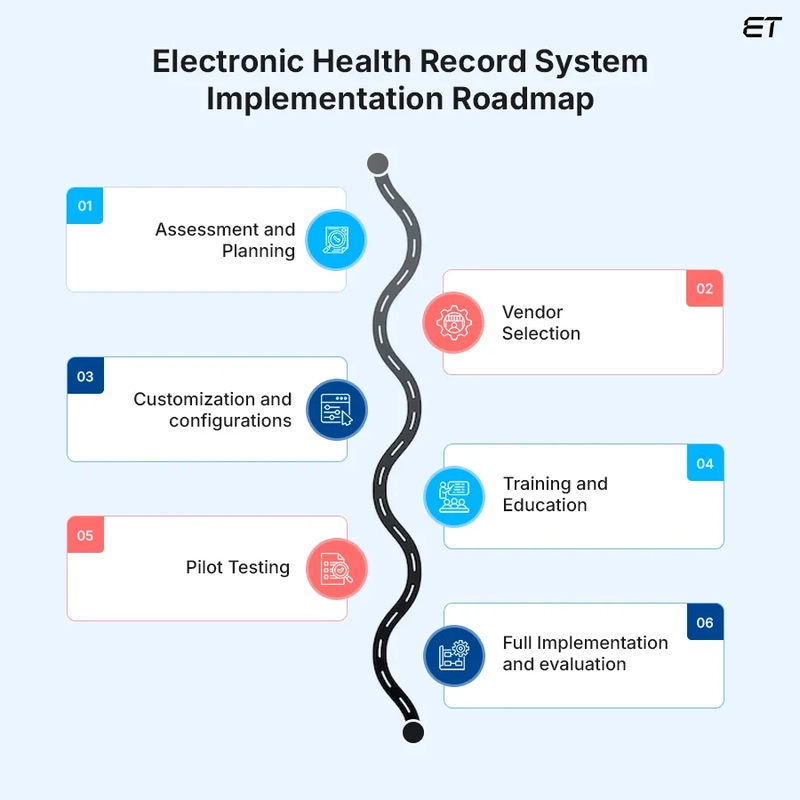
Does your team feel overwhelmed by endless technology choices? As markets evolve and consumer needs shift, businesses must bring changes to stay competitive. A technology roadmap is your compass, guiding you through the chaos. But what exactly is it, and why does your business need one? Let’s dive in!
This blog will answer all your questions about why, when, and how to create a technology roadmap. But if you want a quick glimpse, check out the example below!
“A healthcare company implementing electronic health records (EHR) used a technology roadmap to streamline adoption, ensuring seamless integration, staff training, and data security. This strategic planning reduced downtime, improved patient care, and aligned IT investments with long-term business goals.”
Technology or IT roadmaps are visual representations of your strategy plan for using technology to assist your business and clients. They can be a hidden weapon for navigating technological changes and ensuring they support a company's objectives while also helping to create a vision for the future.
According to Statista, between 2023 and 2027, over 86% of businesses intend to use digital platforms and apps.
However, any modification to a company's technological environment might be challenging. Preparing for these shifts can be difficult, but a firm cannot only survive but also prosper during downturns if it has the proper information, research, and—above all—a well-defined plan that empowers them to face the challenges with confidence and security.
The technological roadmapping directs email migrations, network improvements, and software rollouts to ensure seamless changes. The roadmaps provide a coordinated approach to digital modernization, ensuring a structured and strategic transition. They offer reassurance and reduce stress by aligning stakeholders through clear objectives, deadlines, and essential activities.
This article explores the idea of a technology roadmap, outlining its goals while giving guidelines for creating one that will guarantee a successful and seamless technological journey. Learn how to incorporate product development as well for a more seamless future.
Turn your ideas into a successful product with the right strategic roadmapping approach for efficient planning and execution.
What is a Technology Roadmap? Everything You Need to Know
A technology roadmap is a planning tool in which an organization's technology efforts' vision, direction, and progress are described. Its main goal is to match technological projects and investments with the main business goals.
It is basically a visual depiction of your technological path that highlights significant turning points, dependencies, and resource needs. If applicable, a successful technology roadmap should also include a plan for achieving both short- and long-term objectives related to digital transformation.
A technology roadmap brings your development, project management, and other teams together by connecting your IT needs with business objectives. Your management and technology teams may clearly outline a course for the future by documenting this journey, which will help you match your investments with your long-term goals.
A lot of software development teams illustrate their roadmaps using tools like Canny or GitHub. However, other teams still use spreadsheets to organize their roadmaps. Well-known examples are Google Sheets and Airtable.
Let’s take some simple examples to comprehend this topic further.
Understanding Technology Roadmaps with a Real-World Example
Here are a few examples of technology roadmaps to help you understand their structure and implementation, providing insights into how they are designed and executed for strategic planning.
Technology Upgrade Roadmap Example
In this dynamic digital world, companies frequently have to update or upgrade their current technological infrastructure. A company may develop a roadmap to upgrade its server infrastructure, replacing aging servers with cloud-based solutions, adopting new cybersecurity protocols, and enhancing data storage capabilities.
The technological complexities that a business may face are captured in this roadmap, which is more than just a strategy for linear advancement. By predicting the organization's technological demands and trends, it facilitates efficient decision-making to optimize expenditures and resources and guarantee uninterrupted company operations.
Have a look at the below template, which top software development companies generally follow for technology upgrades
Key components of a technology upgrade roadmap include:
- Assessment of current technology: Identify existing bottlenecks or limitations in the infrastructure.
- Planning and research: Determine which technologies need to be upgraded, researched, or replaced.
- Execution phase: Install new software, replace outdated hardware, and ensure smooth integration with the existing systems.
- Post-upgrade maintenance: Provide ongoing support, monitor performance, and address issues as needed.
Enterprise IT Technology Roadmap Example
A company's IT department's strategic strategy is laid out in this internal IT roadmap, which emphasizes important areas like cybersecurity activities, system integrations, and infrastructure upgrades. For example, a healthcare provider might create an IT infrastructure roadmap to improve data management and integrate electronic health records (EHR) systems for better patient care coordination.
An efficient IT roadmap will outline your company's present IT capabilities, future IT requirements, and any enhancements you intend to implement in line with your business plan. Examine the template below, which is what we use for this kind of roadmap.
Key components include:
- Current state assessment: Audit current IT infrastructure and identify any vulnerabilities.
- Prioritization of upgrades: Determine which areas need immediate attention, such as network security, cloud adoption, or data management.
- Implementation and transition: Migrate systems, implement new tools, and ensure training and change management strategies.
- Maintenance: Set up procedures for monitoring and maintaining the new infrastructure.
Types of Technology Roadmaps: From Product to IT Strategy
Each type of roadmap is crucial for driving technology projects, aligning with business objectives, and maintaining a competitive edge. The right tool effectively communicates priorities and direction, whether using feature-based, goal-oriented, or timeframe roadmaps. Explore the different types of technology roadmapping approaches for your team.
-
Product Roadmap
It is one of the most commonly used roadmaps. It describes the goal, process, and schedule for a product's release. Long-term developments, updates, and important features are all included. Product managers and development teams can use it to prioritize features and coordinate cross-functional activities, which is especially helpful.
-
Infrastructure Roadmap
This roadmap focuses on elements of the IT infrastructure, such as servers, networks, storage, and cloud adoption. An efficient IT roadmap will outline your company's present IT capabilities, future IT requirements, and any enhancements you intend to implement in line with your business plan. It is used by software development teams, IT managers, and CIOs to make sure that the organization's IT capabilities are future-proof and in line with its business objectives.
-
Technology-Specific Roadmap
A technological roadmap assists firms in deciding which technologies to invest in and how to implement them as they set out their strategy and implementation to help execute on their vision. It directs an organization's acceptance and effective use of a specific technology. It basically facilitates the enhancement of technology infrastructure to meet the organization's or business's short- and long-term goals.
Find the best front end technologies to develop the application in 2025.
-
AI & Innovation Roadmap
An organization's plan for successfully implementing and scaling AI technology is called an artificial intelligence roadmap. It directs research, pilot projects, and implementation schedules, guaranteeing that companies maintain their competitiveness by utilizing innovation to increase productivity, customer engagement, and market leadership while staying in line with long-term corporate goals.
Key Artificial Intelligence Statistics 2025 You Must Know.
-
Strategic Roadmap
A strategic roadmap, also known as a strategy roadmap, is a graphic representation of how you will achieve your objectives within a specified time period. Developing and sharing a strategy roadmap makes your goals more clear. Because it provides important context about how actions relate to impact, it is a great tool for bringing teams together around common goals.
-
Cybersecurity Roadmap
In contrast to the gaps and vulnerabilities that cybersecurity leaders find during strategic planning, a cybersecurity roadmap explicitly ranks projects and corrective actions. Risk evaluation, security improvements, and compliance procedures are all included. Through this roadmapping, enterprises may comply with industry laws and reduce cyber threats.
Read about how Python is helping cybersecurity.
How a Technology Roadmap Enhances Planning and Execution?
Technology roadmaps improve strategic alignment and organizational effectiveness in a number of ways. Organizations can better comprehend and envision their technical needs over time with the use of these roadmaps. Overall, these tech roadmaps are incredibly useful tools for controlling risks and shifting to changing market conditions. Let's cover all the benefits of using technology roadmap templates.
-
Better communication
By clearly and systematically outlining IT goals, a roadmap facilitates communication between technical and non-technical stakeholders. Executives are able to efficiently monitor development and make well-informed strategic decisions because of this transparency. All things considered, this strategy serves as a shared point of reference that minimizes miscommunications and guarantees that everyone is pursuing the same objectives.
Read our detailed guide on software development collaboration tools.
-
Enhance Decision Making
Businesses may make well-informed technological decisions based on impact, efficiency, and priority when they have a clear roadmap. Concentrating on upcoming trends reduces the danger of investing in obsolete or superfluous technologies. Additionally, by identifying high-priority activities, it assists administration in efficiently allocating budgets.
Top 10 enterprise AI trends dominating the market in 2025.
-
Supports Innovation
Since technology is always changing, you must plan for system upgrades, introduce new tools, and provide the platforms required for initiatives to transform. In this way businesses can maintain their competitiveness by developing a technology plan. Effective technology roadmapping pushes companies to use cutting-edge technology like blockchain, cloud computing, automation, and artificial intelligence.
-
Improved Strategic Planning
The right roadmaps help businesses plan strategically by identifying potential challenges and risks in technology projects, allowing them to prepare in advance and avoid obstacles. Organizations may maintain their agility, responsiveness, and competitiveness by using this proactive approach. Infrastructure investments, human resources, and IT budgets can all be optimized with the aid of a clear strategy.
-
Avoid Unnecessary Expenses
Tech roadmaps help organizations avoid overspending on redundant or low-priority technology projects. It allows for better financial planning by forecasting future IT investments. Moreover, using tech roadmaps prevents costly emergency fixes by proactively addressing potential risks and system inefficiencies.
Find the staff augmentation cost in 2025.
-
Alignment of Stakeholders
Building trust and goodwill with internal teams and leadership is facilitated by transparency. Regular roadmap presentations and demos are effective means of providing status updates and getting input from your cross-functional coworkers. Technology roadmaps help stakeholders come together by defining shared objectives and priorities, which results in a cohesive vision. Cross-functional cooperation is promoted, and resource allocation is guaranteed by this common framework.
Create a powerful, feature-rich app with the perfect roadmap—start your journey to success today!
What Makes a Strong Technology Roadmap? Key Elements Explained?
A strong roadmap is essential for guiding technology implementation and ensuring alignment with business goals. Here are the key elements that make a technology roadmap effective:
| Elements | Explanation |
Vision |
A technology roadmap aligns IT investments with business operations by outlining both short-term and long-term objectives. It provides quantifiable, time-bound goals, guaranteeing clarity about system evolution and upkeep. Setting goals facilitates the "why" behind projects, bolsters strategic planning, and illustrates how technology contributes to corporate success. |
Resources |
Each initiative requires human, financial, and technological resources, including time, capital, and personnel. IT teams must manage new technology rollouts while maintaining existing systems. A clear roadmap ensures cross-functional coordination, minimizes dependencies, and ensures smooth implementation and system functionality. |
Key Milestone |
Milestones are important events that signal a major advancement in the execution of a technology project. This could involve successful testing, deployment, or the conclusion of project phases. With the right roadmapping, stakeholders can evaluate and comprehend the advancement of their long-term objectives when they keep track of milestones. |
Risk factors |
There are possible problems that could prevent technological efforts from being implemented successfully. These risks can be identified and explained in your tech roadmap. Risk issues can include the technology's inherent limitations, challenges in implementing the new technology, like a poor user interface, or market changes that impact the organization's or business's objectives and demands. |
Status Report |
Technology roadmaps require team members to stay in constant communication, and status reports help with this. Each of the relevant parties is kept up to date on the deployment of new technology through status reports. |
Dependencies |
Technology endeavors are interconnected, with specific projects relying on the completion of others, which can lead to a few challenges. Market conditions, team capacity, and technological limitations are a few examples of challenges. Planning ahead and properly managing dependencies are crucial because these obstacles can impede progress. |
Training |
Whenever a new technology system is introduced, it should include support or documentation with usage instructions. Training is essential for both onboarding new users and updating existing systems, ensuring seamless adoption and effective utilization of the new technological capabilities. |
Timeframe |
Decide on a short-term (months to a year), medium-term (one to three years), and long-term (three or more years) timeline for your roadmap. Add dates and milestones and make a distinction between when the new feature is ready for users and when the team is ready. |
How to Build a Technology Roadmap for Long-Term Success?
Below are the key steps to creating a successful technology roadmap. By following these steps, organizations can create a technology roadmap that drives innovation, improves efficiency, and supports long-term business success.
1. Define Business Goals and Vision
Setting clear and specific strategic goals is the first stage in creating a technological roadmap. "How is this IT change going to help our business?" Put your concise answer at the top of your technological roadmap.
The high-level goals that specify the ideal future state of an organization are known as strategic objectives. These should provide a clear understanding of the objectives of your IT efforts and be tightly linked to the overarching business objectives of your organization.
Use a SWOT analysis to evaluate your technological roadmap's strengths, weaknesses, opportunities, and threats in order to determine its strategic path. Clearly define your future vision and ascertain how technology will help achieve your company's objectives.
After setting strategic objectives, define specific, actionable goals to achieve your vision. Here’s how you can turn objectives into action:
- Break objectives into smaller tasks.
- Establish Key Performance Indicators (KPIs) to measure progress.
- Prioritize initiatives based on importance and alignment to ensure critical tasks are addressed first.
An example of the goals and initiatives you might include on a technology roadmap
2. Determine Roadmap’s Audience (Key Stakeholders)
A technology roadmap should be accessible to all stakeholders, including business users, IT specialists, and executives. Identify your audience to ensure the roadmap is presented in a clear, understandable language for effective communication.
Web-based roadmap software is what you should use if you intend to distribute the roadmap to several audiences. It enables you to quickly and simply create multiple versions of the same roadmap and seamlessly transition between them while presenting.
3. Establish Roadmap Theme
Now that you have established your goals and objectives, it's time to make a plan out of them. Starting with the highest-level actions is what you should do. Themes are the high-level strategic components of a roadmap, and epics come next. (A single high-level theme can encompass a number of related epics.) These themes stand for the broad areas of concentration that will direct your technology projects in the future.
For example, if your technology roadmap focuses on improving customer interactions, the key initiative could be "Enhancing Customer Interaction Channels." Related projects might include developing a mobile app, integrating AI-powered customer support, and implementing a new CRM system to streamline communication and enhance customer experience across multiple touchpoints.
4. Gather Stakeholder Input
Your technology roadmap should be shared with all pertinent stakeholders once it is in line with a specific theme. By distributing the roadmap, all parties may see the strategic direction, comprehend their responsibilities, and work together to accomplish the stated goals.
Tools like ClickUp allow you to safely share your roadmap with those who have specific rights. Utilize the Gantt Chart view to manage dependencies, monitor workflows, track activities in real time, and quickly modify timelines using its drag-and-drop functionality.
5. Define Technology Initiatives and Priorities
Although there are many activities on a technology agenda, resources are limited. Therefore, prioritization is crucial to make sure the roadmap concentrates on projects with the most impact. Identify every possible technological initiative, update, and new application. Sort them into important categories, including automation, cloud adoption, security, AI integration, and infrastructure upgrades. Initiatives should be prioritized according to their urgency, viability, and business impact.
Enhance Business Automation Solutions with Custom Web App Development
Incorporate sufficient information to ensure that the entire IT team is aware of the intended result. It's possible that you will engage with an internal product manager to define features and requirements.
Top 7 IT staff augmentation companies in 2025.
6. Allocate Resources & Manage Risk & Budget
For a technology roadmap to be successful, risk management and efficient resource allocation are necessary. When making plans, take into account your technological, human, and financial resources. Assign duties, prioritize projects, estimate timetables, and break down themes into manageable tasks. Besides this, team evaluations must be conducted to decide on the sequence of execution.
Create a budget plan that accounts for hardware, software, training, and maintenance, making sure that resources are distributed and funded appropriately to avoid delays and maintain project momentum.
Find risk mitigation strategies for successful IT projects.
Determine any risks, difficulties, and limitations (such as financial restrictions, legal requirements, and inter-team dependencies). Evaluate potential hazards that can obstruct progress to reduce and manage risk. Moreover, create plans for contingencies, acquire more resources, and set up performance monitoring systems as part of your risk mitigation methods.
7. Develop an Execution Plan
Now that all key stakeholders have reviewed and understood the plan, it's time to assign roles and execute tasks. Clearly defined responsibilities ensure the technology roadmap is implemented efficiently, keeping progress on track as planned.
Set deadlines, define important activities, and create workflows to ensure efficient execution. Use effective progress tracking and management techniques to keep projects on track and in line with strategic goals.
A process mapping tool can be used to prioritize activities, assign them with due dates, and monitor their progress. Initiatives should be broken down into manageable segments to guarantee responsibility, clarity, and timely completion.
8. Monitor & Make Adjustments
A technological roadmap's projects usually take several months to finish. Your plan should be updated to take into account emerging challenges, technological advancements, and changes in business operations.
As a result, it is necessary to use Key Performance Indicators (KPIs) like system uptime, cost savings, or process automation rates to regularly monitor progress.
Maintain the roadmap's flexibility to accommodate changes in the market and in technology. To increase efficiency, get input from stakeholders and implement changes.
You can use project management software like Jira or a project tracking template to keep tabs on resource allocation, task completion, and deadlines.
By following these steps, you can create a technology roadmap that effectively aligns with business goals, ensuring successful execution and achieving the desired outcomes efficiently.
Unlock success by strategically roadmapping your journey to develop a powerful, feature-rich application that aligns with your product vision and goals.
Technology Roadmap Challenges: Common Pitfalls and How to Overcome Them
Have a look at the common challenges and their possible solutions.
| Challenges | How to solve? |
Rapid Technological Changes |
Technology evolves quickly, making it difficult to plan for long-term initiatives. Solution: Businesses must regularly update their roadmap to adapt to emerging trends and avoid outdated strategies. |
Stakeholders Dictate Roadmap |
Specific features are frequently requested by stakeholders but merely including them can result in a disorganized product with a poor value proposition. Solution: Their opinions are valuable, but decisions should be based on the product strategy. |
Overdependency on Tools |
A well-designed roadmap matters more than the tool used to create it. Solution: Before investing in specialized software, establish a clear roadmap approach. Even simple tools like spreadsheets or PDFs can be effective if they support collaboration and alignment. |
Limited Resource Allocation |
Limited financial, human, and technical resources can create roadblocks. Solution: Organizations must carefully allocate budgets, assign skilled personnel, and ensure that existing systems support new initiatives. |
Feature-Based Roadmap |
Traditional product roadmaps prioritize features over outcomes, leading to a "feature-factory" mindset and roadmap rigidity. Solution: Focusing more on a goal-oriented approach that ensures flexibility, emphasizing outcomes like user engagement, customer acquisition, and technical improvements, with features serving broader strategic goals. |
Managing Dependencies & Risk |
Technology projects often depend on other initiatives, teams, or external factors. Delays in one area can disrupt the entire roadmap. Solution: Identifying risks and dependencies early is crucial for smooth execution. |
Optimizing Your Technology Roadmap: Best Practices to Follow
Leading development companies follow the below-given practices that help us create a technology roadmap that drives innovation, improves efficiency, and ensures sustainable growth in an evolving digital landscape.
- Align with business objectives: Make sure every activity supports the long-term vision and that the roadmap directly supports the business's strategic goals.
- Cross-functional collaboration: Collaborate with executives, IT teams, product managers, and end-users to gather insights and define priorities.
- Prioritize initiatives: Give priority to projects that have a measurable impact by taking into account possible revenue growth, cost savings, or improved efficiency.
- Use Measurable KPIs: Establish key performance indicators (KPIs) to track progress, evaluate success, and make data-driven decisions.
Benefits of KPIs for software development.
Ensure Flexibility and Scalability: Technology evolves rapidly, so keep your roadmap adaptable to accommodate new trends and innovations.
Allocate Resources Effectively: Plan for financial, technical, and human resources to avoid bottlenecks and delays.
Effective Tips for Sharing Your Technology Roadmap with Stakeholders
In Step 4, we recommended presenting your roadmap to key stakeholders to gain their understanding and support. To enhance the success of that meeting, consider these essential tips for effectively sharing your tech roadmap.
Use Clear and Simple Visuals: Present your roadmap using charts, timelines, and dashboards to make it easy to understand. Tools like ClickUp or Jira can help visualize dependencies and priorities.
Highlight Business Impact: Focus on how the roadmap supports business goals, improves efficiency, and drives innovation rather than just listing technologies.
Encourage Feedback and Collaboration: Create a feedback loop through meetings, forms, or collaborative platforms to incorporate stakeholder insights and ensure buy-in.
Provide Regular Updates: Technology evolves, so keep stakeholders informed with periodic roadmap reviews and revisions.
Align with Execution Plans: Ensure the roadmap connects with project timelines, resource allocation, and agile workflows for seamless implementation.
By following these tips, you can effectively share your technology roadmap, ensuring alignment and a smooth execution of your strategic initiatives.
Best Tools for Technology Roadmapping
At eLuminous Technologies we generally prefer the below-given tools that help streamline technology roadmapping by providing visualization, collaboration, and tracking capabilities. Here are some top options:
| Tool | Description |

|
Ideal for agile teams, Jira enables backlog management, sprint planning, and roadmap visualization through its Advanced Roadmaps feature. |
 |
It is a powerful product roadmapping tool that enables teams to define strategy, set goals, and track progress with customizable views. |
 |
It allows teams to create timeline and swimlane-style roadmaps while integrating with Jira for seamless development tracking. |
 |
A visual project management tool that can be customized for roadmapping using boards, lists, and cards. |
 |
It offers flexible roadmapping features, including Gantt charts, task dependencies, and collaboration tools to align teams. |
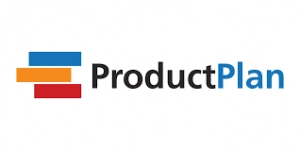 |
It is a user-friendly tool that helps create shareable roadmaps, prioritize initiatives, and align stakeholders. |
Plan, Innovate, and Execute Your Tech Roadmap
To stay ahead in a fast-changing tech world, a clear technology plan is essential. Roadmaps help prioritize projects and guide long-term planning, ensuring smooth progress and alignment with business goals. They support businesses in predicting market trends, identifying future technological requirements, and making plans for integrating cutting-edge technologies.
Software Development Best Practices in 2025 for Success.
Make the most of a technological roadmap by coordinating it with business objectives, establishing distinct priorities, and keeping up with market developments. This is only achievable by encouraging teamwork, monitoring advancement using important metrics, and routinely revising the plan to guarantee long-term success and strategic expansion.
A well-crafted tech roadmap ensures seamless implementation, driving long-term success and innovation. So, what exactly do you need to do?
Plan strategically by defining goals, aligning technology with business objectives, and setting clear milestones.
Innovate by leveraging emerging technologies, gathering stakeholder input, and adapting to industry trends.
Execute efficiently with structured workflows, resource allocation, and performance tracking.
Looking to elevate your technology roadmap? Let’s collaborate to drive impactful results, align strategies, and ensure seamless execution for long-term success. Connect with us today to optimize your technology roadmap and achieve your business goals.
Frequently Asked Questions
Why should I use a technology roadmapping template for my project?
A technology roadmapping template streamlines planning, ensuring alignment with business goals, clear timelines, and efficient resource allocation. It enhances collaboration, tracks progress, and simplifies adjustments, helping teams stay organized and focused on achieving strategic objectives with minimal effort.
What is the cost of using tech roadmaps?
The cost of using technology roadmaps varies based on factors like software tools, team size, and project complexity. Expenses may include software subscriptions, consulting fees, training, and resource allocation, but the benefits of strategic planning and efficiency often outweigh these costs.
Who helps in building the right roadmap?
Building the right roadmap involves collaboration between key stakeholders, including product managers, IT leaders, dedicated developers, business executives, and end-users. Their combined insights ensure alignment with business goals, technological feasibility, and user needs for a successful implementation.
Plan Smart, Build Better – Create a Feature-Packed App Today!











































































































































































![[The AI Show Episode 142]: ChatGPT’s New Image Generator, Studio Ghibli Craze and Backlash, Gemini 2.5, OpenAI Academy, 4o Updates, Vibe Marketing & xAI Acquires X](https://www.marketingaiinstitute.com/hubfs/ep%20142%20cover.png)




























































































































![[DEALS] The Premium Learn to Code Certification Bundle (97% off) & Other Deals Up To 98% Off – Offers End Soon!](https://www.javacodegeeks.com/wp-content/uploads/2012/12/jcg-logo.jpg)


![From drop-out to software architect with Jason Lengstorf [Podcast #167]](https://cdn.hashnode.com/res/hashnode/image/upload/v1743796461357/f3d19cd7-e6f5-4d7c-8bfc-eb974bc8da68.png?#)








































































































.png?#)

































_Christophe_Coat_Alamy.jpg?#)
 (1).webp?#)





































































































![Apple Considers Delaying Smart Home Hub Until 2026 [Gurman]](https://www.iclarified.com/images/news/96946/96946/96946-640.jpg)
![iPhone 17 Pro Won't Feature Two-Toned Back [Gurman]](https://www.iclarified.com/images/news/96944/96944/96944-640.jpg)
![Tariffs Threaten Apple's $999 iPhone Price Point in the U.S. [Gurman]](https://www.iclarified.com/images/news/96943/96943/96943-640.jpg)

































































































































